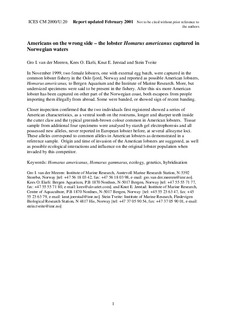Americans on the wrong side – the lobster Homarus americanus captured in Norwegian waters
Abstract
In November 1999, two female lobsters, one with external egg batch, were captured in the
common lobster fishery in the Oslo fjord, Norway and reported as possible American lobsters,
Homarus americanus, to Bergen Aquarium and the Institute of Marine Research. More, but
undersized specimens were said to be present in the fishery. After this six more American
lobster has been captured on other part of the Norwegian coast, both escapees from people
importing them illegally from abroad. Some were banded, or showed sign of recent banding.
Closer inspection confirmed that the two individuals first registered showed a series of
American characteristics, as a ventral tooth on the rostrums, longer and sharper teeth inside
the cutter claw and the typical greenish-brown colour common in American lobsters. Tissue
sample from additional four specimens were analysed by starch gel electrophoresis and all
possessed new alleles, never reported in European lobster before, at several allozyme loci.
These alleles correspond to common alleles in American lobsters as demonstrated in a
reference sample. Origin and time of invasion of the American lobsters are suggested, as well
as possible ecological interactions and influence on the original lobster population when
invaded by this competitor.
Publisher
ICESSeries
ICES CM documents2000/U:20
